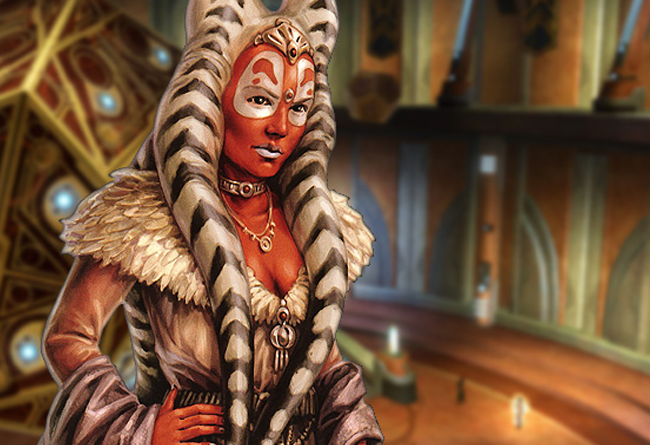Species: Togruta
Home Planet: Shili
Attribute Dice: 13D
DEXTERITY 2D/4D+2
KNOWLEDGE 2D/4D+1
MECHANICAL1D/4D
PERCEPTION 2D/4D+1
STRENGTH 1D/3D+2
TECHNICAL 1D/4D
Special Abilities:
Camouflage: Togruta characters possess colorful skin patterns which help them blend in with natural surroundings (much like the stripes of a tiger). This provides them with a +2 pip bonus to hide skill checks.
Spatial Awareness: Using a form of passive echolocation, Togruta can sense their surroundings. If unable to see, a Togruta character can attempt a Moderate search skill check. Success allows the Togruta to perceive incoming attacks and react accordingly by making defensive rolls.
Story Factors:
Believed to be Venomous: Although they are not poisonous, it is a common misconception by other species that Togruta are venomous.
Group Oriented: Togruta work well in large groups, and individualism is seen as abnormal within their culture. When working as part of a team to accomplish a goal, Togruta characters are twice as effective as normal characters (ie, they contribute a +2 pip bonus instead of a +1 pip bonus when aiding in a combined action; see the rules for Combined Actions on pages 82-83 of SWD6).
Move: 10/12
Size: 1.7-1.9 meters
Background: Togrutas were a sentient humanoid species, characterized by their colorful skin tones, large montrals, head tails, and white facial pigments. They hailed from the planet Shili, in the Expansion Region. Although Shili was their homeworld, they also had a colony of some 50,000 individuals on the planet Kiros, also in the Expansion Region. Some well known Togruta included the Jedi Master Shaak Ti, Supreme Chancellor Kirames Kaj, and Padawan Ahsoka Tano.
Togrutas were a species of humanoids whose skin spanned a vast array of colors, including, but not limited to, orange, green, red, white, and yellow. These characteristics were a result of evolution; Togruta coloration was helpful as a method of camouflage from predators. Unlike most humanoids, Togrutas were known to have multiple stomachs, however their most notable features were the large organic head formations upon their heads; two large cone-like horns called montrals atop their skull, and three lekku, also known as ‘headtails’, that sprouted downward. Both a Togruta’s lekku and montrals tended to grow longer as they aged, with females having longer lekku than the males. A Togruta’s montrals allowed them to sense the movement of objects around them through echolocation, and could sense up to 82 feet.

